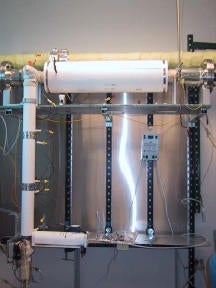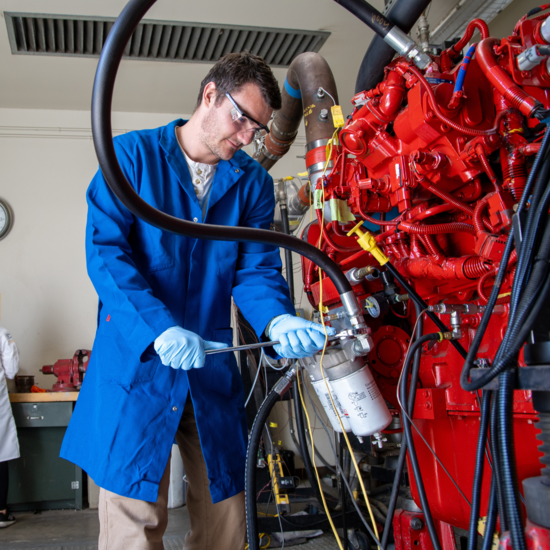Emission Testing Laboratories
Overview
The Emission and Fuels Research team at CE-CERT leads cutting-edge investigations into real-world emissions across diverse applications. By combining advanced laboratory facilities, mobile testing platforms, and field campaigns, CE-CERT delivers actionable data to inform regulatory standards, guide technology development, and improve air quality. Our work spans from evaluating portable emission measurement systems to characterizing emissions from marine vessels, commercial vehicles, and even cooking appliances.
Serving as a neutral, science-based resource for industry, academia, and government agencies, CE-CERT provides independent assessments that support cleaner fuels, cleaner engines, and cleaner air.

Research and Impact
-
Multisector Emissions Testing: From heavy-duty diesel trucks to marine engines and biomass cookstoves, CE-CERT evaluates emissions performance under real operating conditions.
-
Policy-Relevant Data: Findings support California Air Resources Board (CARB), U.S. EPA, and other agencies in setting emissions standards and certifying clean technologies.
-
Technology Development: CE-CERT partners with manufacturers and startups to assess prototype performance and optimize emissions control strategies.
-
Air Quality Solutions: Research findings contribute directly to improved understanding of air toxics, ultrafine particles, and the role of emerging fuels in public health outcomes.
Testing Services
Contact for pricing and lab availability:
Kent Johnson
(951) 781-5786
kjohnson@cert.ucr.edu
-
Cooking Emissions Test Kitchen
Reducing Emissions Through Cleaner KitchensEmissions from commercial and non-commercial kitchens can have a substantial impact on the quality of our air. In addition to cooking by-products such as grease, smoke, and heat, cooking methods such as charbroiling are known to generate large amounts of particulate matter. As a result, several air quality agencies in California are exploring the possibility of requiring cooking operations to install control devices. CE-CERT’s test kitchen facility is designed to capture and analyze the emissions generated by a variety of cooking equipment, providing researchers with data critical to the development of policy around the manufacturing, maintenance, and use of such equipment.Service DetailsFees are billed per basic test day (up to 8 hours) which includes the following:
-
Oversight of manufacturer device installation
-
Ordering of supplies for testing
-
Set up of test equipment
-
Testing
-
Data processing, QA, and reporting
If the same device is to be tested repeatedly, a 10% labor discount can be given for the reduced effort in oversight of new device installation. Please note that the following items are NOT included in the rate listed above: test plan development, data analysis and reporting beyond established standards, negotiation of shipping and delivery details with vendors, or any similar tasks. -
-
Marine Mobile Emissions Laboratory
Measuring the Concentration of Gases, Particulate Matter (PM) Measurements, and Other Emissions
In-Use Marine Mobile Emissions LaboratoryCE-CERT's marine laboratory features multi-gas analyzers (Horiba PG350) to measure the concentrations of carbon monoxide (CO), carbon dioxide (CO2), oxygen (O2), nitric oxide (NOx), and sulfur oxide (SOx) gasses in raw exhaust, as well as to provide particulate matter (PM) measurements for diluted exhaust. Unlike other portable gas analyzers that rely upon electrochemical sensors, the Horiba PG-350 utilizes the same measurement principles as a permanently installed CEMS and is in compliance with MARPOL ANNEX VI. The methods utilized are state-of-the-art and follow ISO 8178 as well as 1065 measurement protocols.Heavy Fuel Oil (HFO) Marine 2-Stroke Engine Test PlatformCE-CERT is home to a one-of-a-kind marine engine test-stand system for the evaluation of marine fuel emissions, after-treatment systems, and other novel ideas for the marine sector. This laboratory has been operated on commercial heavy fuel oils (HFOs) with a wide range of viscosities.The marine test engine:-
2-stroke Detroit Diesel Model 6-71N (naturally aspirated)
-
In-line 6-cylinder configuration
-
Maximum rated speed of 2300 RPM (range 1100-2300 RPM)
-
Maximum engine power of 187 kW
-
Brake mean effective pressure (BMEP) of 641 kPa
-
Associated rated brake specific fuel consumption (BSFC) of 307 g/kWh (0.505 lb/hp-hr) at 1100 RPM (N70 injectors used during testing).
This type of engine is typically used on small vessels or as an auxiliary engine on ocean-going vessels (OGVs). OGVs usually switch to auxiliary engines when approaching ports or other areas where more maneuvering is required. -
-
Mobile Emissions Laboratory
Measuring the Emissions of Large Stationary EnginesUCR’s Mobile Emission Laboratory (MEL) connects to the total exhaust of a diesel or alternative-fueled heavy-duty engine to collect certification-grade emissions measurements. The lab is housed inside a tractor-trailer, so it can be connected to a heavy-duty truck cab and collect measurements while going down the road, transported to any facility to measure and certify large stationary engines, or used in conjunction with UCR's or others heavy-duty engine or chassis dynamometer. MEL collects information on a wide range of pollutants including criteria, toxics, NH3, and particle size and number. MEL is 1065 compliant and is validated with the California Air Resource Board’s and Southwest Research Institute’s heavy-duty diesel laboratories.Service DetailsMEL Testing Options:
• MEL Prep Day
• MEL Test Day
• Additional NH3 (per week) -
OSAR Laboratory
Simulating Power Plant Exhaust SystemsCE-CERT in partnership with EmiSense Inc. LLC developed a simulation laboratory to research onboard sensors and other needs for exhaust simulation. This laboratory is designed to operate up to 700 C, high water concentrations of up to 15% water, and various concentrations of SO2, NO, NO2, NH3, HC’s and O2, and various other species of interest. The laboratory has excellent thermal management controls and is easily configured for various research projects.

This laboratory is ideal for sensor aging, evaluation, and characterization, In addition, it can be used for catalyst formulation, exhaust sensor development, durability studies, and other development projects where controlled exhaust conditions are desired. There are three main elements of the laboratory mass flow control of the gaseous species injection, water injection and steam generation, and heater controls.
The laboratory includes a high (up to 40 lpm) and low flow (up to 2 lpm) operation, an integrated FTIR, Minicast soot generator, automated thermal cycling test stand, IR camera for surface temperature scanning (1000 C), Solartron EIS measurements (impedance and frequency response), oscilloscope to view electrical signals, and a PG350 gas analyzer (NO, NO2, CO, CO2, and O2)Gaseous water is introduced into the blended sample gas stream in order to provide the desired water content. The water generation system consists of a water reservoir, a graduated burette, a positive displacement pump, and a heating system. The temperature of the sample cell is controlled through a heater capable of maintaining a desired gas temperature up to 750ºF (400ºC) within the cell path. -
Portable Emission Measurement System
Measuring Emissions for On-road and Off-road ApplicationsCE-CERT has a fully 1065-approved gaseous and PM PEMS system for on-road and off-road applications. The PEMS utilizes the AVL M.O.V.E. system for gaseous emission measurements and the AVL 494 system for PM measurements. The AVL M.O.V.E. is equipped with a non-dispersive ultraviolet (NDUV) analyzer for measuring oxides of nitrogen (NO and NO2), a non-dispersive infrared (NDIR) analyzer for measuring CO and CO2, and a flame ionization detector (FID) for measuring total hydrocarbons (THC). The gaseous data is measured as a concentration and is time aligned and flow weighted to the exhaust flow for total mass reporting. All time alignment and flow weighting are performed as part of the post-processor systems for both PEMS. The exhaust flow meter is integrated with the gaseous PEMS and is designed to work with a wide range of exhaust flows and dynamics of transient vehicle testing. The exhaust flow meter uses differential pressure as its measurement principle.
Applications include:-
Off-Road Construction Equipment (PEMS on top of unit shown below)
-
Light Duty Vehicles
-
Trucks and Buses
-
Rail and Marine Vessels
Service DetailPEMS Testing Options:-
Description
-
Gas PEMS only
-
Gas + PM PEMS
-
Lead staff salary
-
PEMS prep
-
